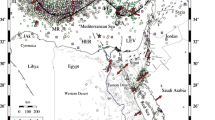Abstract
By using orthogonal regression method, a systematic comparison is made between body wave magnitudes determined by Institute of Geophysics of China Earthquake Administration (IGCEA) and National Earthquake Information Center of US Geological Survey (USGS/NEIC) on the basis of observation data from China and US seismograph networks between 1983 and 2004. The result of orthogonal regression shows no systematic error between body wave magnitude m b determined by IGCEA and m b (NEIC). Provided that m b (NEIC) is taken as the benchmark, body wave magnitude determined by IGCEA is greater by 0.2–0.1 than the magnitude determined by NEIC for M=3.5–4.5 earthquakes; for M=5.0–5.5 earthquakes, there is no difference; and for M≥6.0 earthquakes, it is smaller by no more than 0.2. This is consistent with the result of comparison by IDC (International Data Center).
Similar content being viewed by others
References
Bormann P ed. 2002. New Manual of Seismological Observatory Practice [M]. Potsdam: GeoForschungsZentrum, 2–57.
Geller R J. 1976. Scaling relations for earthquake source parameters and magnitudes [J]. Bull Seism Soc Amer, 66: 1 501–1 523.
Gordon D W. 1971. Surface-wave versus body-wave magnitude [J]. Earthquake Notes, 42(3/4): 20–28.
Gutenberg B. 1945a. Amplitude of surface waves and magnitudes of shallow earthquakes [J]. Bull Seism Soc Amer, 35: 3–12.
Gutenberg B. 1945b. Amplitudes of P, PP and S magnitude of shallow earthquakes [J]. Bull Seism Soc Amer, 35: 57–69.
Gutenberg B and Richter C F. 1956a. Earthquake magnitude, intensity, energy and acceleration (second paper) [J]. Bull Seism Soc Amer, 46: 105–145.
Gutenberg B and Richter C F. 1956b. Magnitude and energy of earthquakes [J]. Annali di Geofisica, 9: 1–15.
HE Xiao-qun and LIU Wen-qing. 2001. The Applications of Regression Analysis [M]. Beijing: China Renmin University Press, 31–39 (in Chinese).
State Seismological Bureau. 1978. Observation Standardization for Seismic Stations [M]. Beijing: Seismological Press, 1–12 (in Chinese).
Utsu T. 1982. Relationships between magnitude scales [J]. Bull Earthq Res Inst, Tokyo Univ, 57: 465–497.
Author information
Authors and Affiliations
Additional information
Foundation item: Project "Seismic Data Share" from China Ministry of Science and Technology.
Contribution No. 05FE3024, Institute of Geophysics, China Earthquake Administration.
About this article
Cite this article
Liu, Rf., Chen, Yt., Peter, B. et al. Comparison between earthquake magnitudes determined by China seismograph network and US seismograph networks (I): Body wave magnitude. Acta Seimol. Sin. 18, 627–631 (2005). https://doi.org/10.1007/s11589-005-0089-6
Received:
Revised:
Accepted:
Issue Date:
DOI: https://doi.org/10.1007/s11589-005-0089-6




